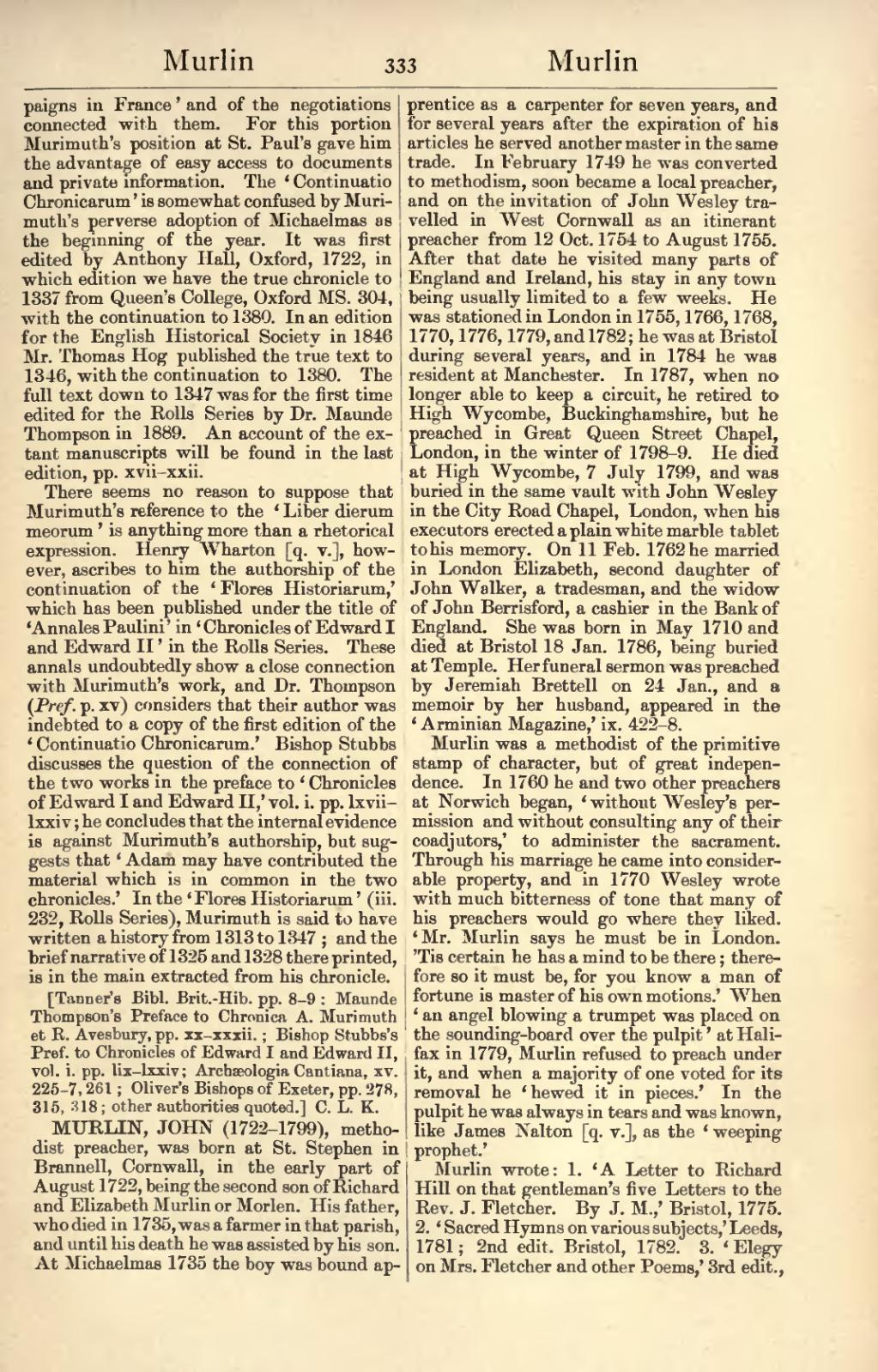paigns in France ' and of the negotiations connected with them. For this portion Murimuth's position at St. Paul's gave him the advantage of easy access to documents and private information. The 'Continuatio Chronicarum' is somewhat confused by Murimuth's perverse adoption of Michaelmas as the beginning of the year. It was first edited by Anthony Hall, Oxford, 1722, in which edition we have the true chronicle to 1337 from Queen's College, Oxford MS. 304, with the continuation to 1380. In an edition for the English Historical Society in 1846 Mr. Thomas Hog published the true text to 1346, with the continuation to 1380. The full text down to 1347 was for the first time edited for the Rolls Series by Dr. Maunde Thompson in 1889. An account of the extant manuscripts will be found in the last edition, pp. xvii-xxii.
There seems no reason to suppose that Murimuth's reference to the 'Liber dierum meorum' is anything more than a rhetorical expression. Henry Wharton [q. v.], however, ascribes to him the authorship of the continuation of the 'Flores Historiarum,' which has been published under the title of 'Annales Paulini' in 'Chronicles of Edward I and Edward II' in the Rolls Series. These annals undoubtedly show a close connection with Murimuth's work, and Dr. Thompson (Pref. p. xv) considers that their author was indebted to a copy of the first edition of the 'Continuatio Chronicarum.' Bishop Stubbs discusses the question of the connection of the two works in the preface to 'Chronicles of Edward I and Edward II,' vol. i. pp. lxvii-lxxiv; he concludes that the internal evidence is against Murimuth's authorship, but suggests that 'Adam may have contributed the material which is in common in the two chronicles.' In the 'Flores Historiarum' (iii. 232, Rolls Series), Murimuth is said to have written a history from 1313 to 1347; and the brief narrative of 1325 and 1328 there printed, is in the main extracted from his chronicle.
[Tanner's Bibl. Brit.-Hib. pp. 8-9: Maunde Thompson's Preface to Chronica A. Murimuth et R. Avesbury, pp. xx-xxxii.; Bishop Stubbs's Pref. to Chronicles of Edward I and Edward II, vol. i. pp. lix-lxxiv; Archseologia Cantiana, xv. 225-7, 261; Oliver's Bishops of Exeter, pp. 2?8, 315, 318; other authorities quoted.]
MURLIN, JOHN (1722–1799), methodist preacher, was born at St. Stephen in Brannell, Cornwall, in the early part of August 1722, being the second son of Richard and Elizabeth Murlin or Morlen. His father, who died in 1735, was a farmer in that parish, and until his death he was assisted by his son. At Michaelmas 1735 the boy was bound apprentice as a carpenter for seven years, and for several years after the expiration of his articles he served another master in the same trade. In February 1749 he was converted to method ism, soon became a local preacher, and on the invitation of John Wesley travelled in west Cornwall as an itinerant preacher from 12 Oct. 1754 to August 1755. After that date he visited many parts of England and Ireland, his stay in any town being usually limited to a few weeks. He was stationed in London in 1755, 1766, 1768, 1770, 1776, 1779, and 1782; he was at Bristol during several years, and in 1784 he was resident at Manchester. In 1787, when no longer able to keep a circuit, he retired to High Wycombe, Buckinghamshire, but he preached in Great Queen Street Chapel, London, in the winter of 1798-9. He died at High Wycombe, 7 July 1799, and was buried in the same vault with John Wesley in the City Road Chapel, London, when his executors erected a plain white marble tablet to his memory. On 11 Feb. 1762 he married in London Elizabeth, second daughter of John Walker, a tradesman, and the widow of John Berrisford, a cashier in the Bank of England. She was born in May 1710 and died at Bristol 18 Jan. 1786, being buried at Temple. Her funeral sermon was preached by Jeremiah Brettell on 24 Jan., and a memoir by her husband, appeared in the 'Arminian Magazine,' ix. 422-8.
Murlin was a methodist of the primitive stamp of character, but of great independence. In 1760 he and two other preachers at Norwich began, 'without Wesley's permission and without consulting any of their coadjutors,' to administer the sacrament. Through his marriage he came into considerable property, and in 1770 Wesley wrote with much bitterness of tone that many of his preachers would go where they liked. 'Mr. Murlin says he must be in London. 'Tis certain he has a mind to be there; therefore so it must be, for you know a man of fortune is master of his own motions.' When 'an angel blowing a trumpet was placed on the sounding-board over the pulpit' at Halifax in 1779, Murlin refused to preach under it, and when a majority of one voted for its removal he 'hewed it in pieces.' In the pulpit he was always in tears and was known, like James Nalton [q. v.], as the 'weeping prophet.'
Murlin wrote:
- 'A Letter to Richard Hill on that gentleman's five Letters to the Rev. J. Fletcher. By J. M.,' Bristol, 1775.
- 'Sacred Hymns on various subjects,' Leeds, 1781; 2nd edit. Bristol, 1782.
- 'Elegy on Mrs. Fletcher and other Poems,' 3rd edit.,
